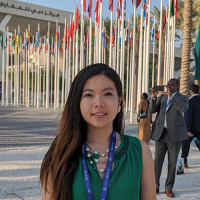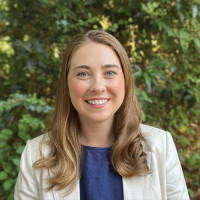Each spring, a group of emerging leaders heads to Washington, D.C., as the latest cohort of John A. Knauss Marine Policy Fellows. They spend the next twelve months in government offices, gaining hands-on experience in marine policy — seeing how science intersects with politics.
In any year, the Knauss Fellowship — which places students who have recently completed, or are actively working on, their doctoral or master’s degrees into full-time roles with the executive or legislative branch — thrusts participants into the complexity of the federal government. “That’s been the biggest lesson so far,” says Roxanne-Alexa Garibay, who is working in the Bureau of Ocean Energy Management, which oversees resources on the Outer Continental Shelf. “There are so many things that happen — that need to happen — in order for you as a citizen to carry on your day.”
And this is not a typical year. The latest cohort of Knauss Fellows arrived in Washington in February, amid significant shifts in administration priorities. A few weeks before the fellowship began, the newly installed administration began to evaluate the size of agencies, part of a larger effort to align the federal budget to new administrative priorities. For California’s Knauss Fellows, that has made the work all the more urgent.
What draws the fellows is often a chance to, as the saying goes, see how the sausage is made. Many have focused on scientific research for years, and have an itch to learn how such science shapes laws and regulations. When Madison Wood, for example, was pursuing her PhD in Earth and Planetary Sciences at the University of California, Santa Cruz, she wound up connecting with Dr. Gabby Kitch, the scientist leading the National Ocean and Atmospheric Administration’s marine carbon dioxide removal program. “As she described the work she does, I realized that science policy was the label for what I was interested in,” Wood says. Kitch had been a Knauss Fellow; Wood decided to apply, too.
Last year, NOAA and the Department of Energy signed a memorandum of agreement laying out how they’d collaborate on initiatives involving marine carbon sequestration. Wood was assigned a joint fellowship position across both agencies, coordinating that partnership; she’d be working directly with Kitch, as well as a mentor at the DOE. Then, within weeks, both mentors were relieved of their positions and no longer working in public service — “and I had on my plate all the wonderful things they were working on,” Wood says. (Because the fellowship positions are funded by Sea Grant, their own roles are unaffected by job reductions.)
She’s been working hard to sustain the interagency connections that were the core of her assignment. That’s been a lesson in building and maintaining relationships, a necessity amid an ever-changing landscape inside the agencies. “The thing that’s keeping me going is how much people at NOAA and DOE care about their jobs, and care about the science they’re doing,” she says.
Eliza Thomas, too, found herself impressed by her colleagues. Her work with NOAA’s Legislative and Intergovernmental Affairs — which equips Congress to address marine issues — includes work with the agency’s Caribbean and Arctic programs and connecting with NOAA officials focused on education. “It’s astounding the level of commitment and passion these people have,” she says. “These are public servants, committed to serving the American people.”
The day-to-day can be unpredictable, but so far, the fellows say, it has been a thorough education. Chia-Chun (Angela) Liang, who works with NOAA’s budget formulation division, has spent her time shadowing the agency’s leadership to watch their daily routines and how they communicate at events and conferences. “It’s really useful to observe their leadership and the power dynamics they have to navigate,” she says. (She’s also sought out independent projects. Liang’s doctoral work, at the University of California, Irvine, sat within a field known as geodesy, the science of measuring and understanding Earth's shape, size, and gravitational field. She learned that the National Geodetic Survey is a NOAA office, and she volunteered to help develop a special edition of a magazine for high school students that will explore how the field’s special knowledge is used in several career paths.)
Kennedy Flavin, meanwhile, was placed with the Democratic staff of the House Natural Resources Committee, specifically working with a subcommittee focused on water, wildlife and fisheries. That means she drafts briefings and even legislation relating to conservation law and endangered species — work that feels all the more important in this moment, as new priorities impact regulatory decision-making. “It feels like I’ve been working for so long,” Flavin said, just a few months into the experience. “We’ve done so much already. But it’s been truly inspiring — and, quite frankly, just fun, even though it’s a crazy moment.”

Kennedy Flavin
University of California, Santa Barbara,
House National Resources Committee (Democratic)
Gardner is deaf and relies on American Sign Language for all communication. “I want to be a person who represents the disability perspective and brings that to the government,” she says. “The government needs disabled people because we are one of the most overlooked minorities."

Roxanne-Alexa Garibay
Moss Landing Marine Laboratories - San José State University
Bureau of Ocean Energy Management Office of Strategic Policy and International Affairs / Office of Environmental Programs
Garibay realized during her academic career that she wanted to do work that was less technical and more visionary. “In this fellowship, I’ve been at the nexus between different people and communities,” she says. “The federal government is just different from community and even state-level work—it’s such a high level of coordination.”

Chia Chun Angela Liang
University of California, Irvine
NOAA National Ocean Service Budget Formulation Division
Liang was at first stressed to arrive in Washington, DC, amid so many changes. Eventually, though, the situation became a motivator. “The Knauss fellowship has made me want to defend science even more, and I’m doing it through a budget perspective,” she says.

Eliza Thomas
Scripps Institution of Oceanography at the University of California, San Diego
NOAA Office of Legislative and Intergovernmental Affairs
“What’s been most inspiring so far is arriving alongside 87 other people, from diverse backgrounds, who are all so committed to this work and the missions of all these environmental agencies,” Thomas says. “They’re all bringing creative ideas and fresh energy.”

Madison Wood
University of California, Santa Cruz
NOAA Ocean Acidification Program/Department of Energy Fossil Energy and Carbon Management Office
Wood has found that, despite the challenges, the fellowship has offered an exciting new perspective on marine science. “After being a PhD student who was siloed for so long on a really particular subject, it’s really exciting to zoom back and think about how the sciences impact American people every day,” she says.